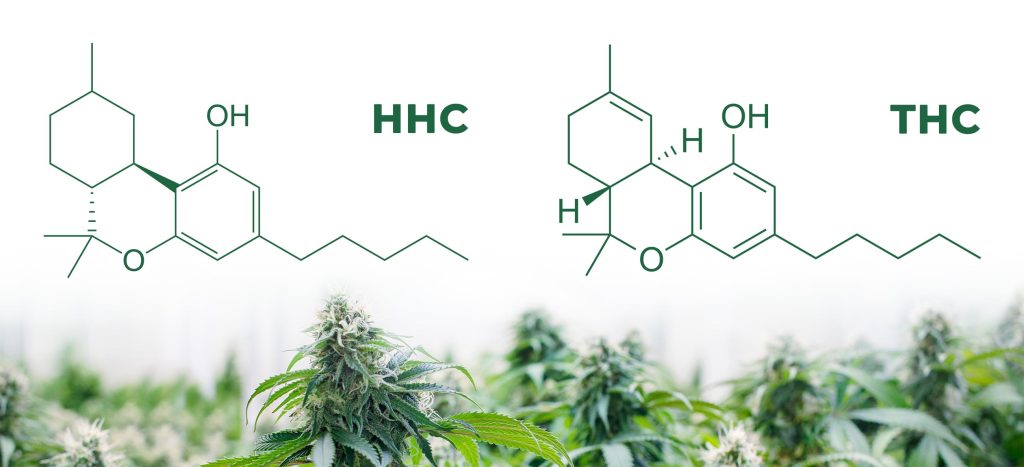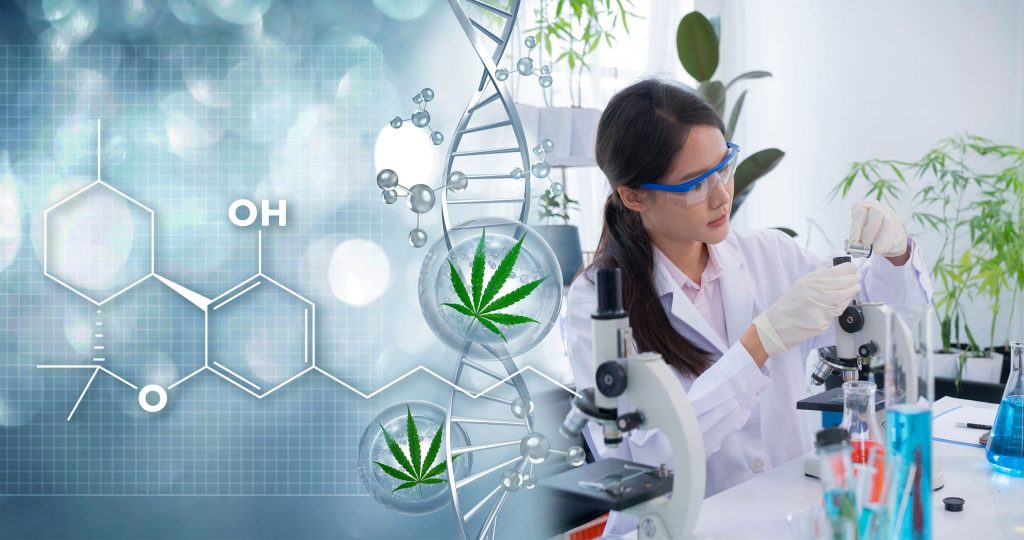If you are curious about cannabis-related novelties, you might have encountered the name HHC in headshops or online. HHC stands for hexahydrocannabinol. It is a cannabinoid that has not yet been researched thoroughly and we know very little about its potential benefits and risks. It does however have some similarities to the more popular cannabis compounds THC and CBD.
Hexahydrocannabinol (HHC) is a compound that has recently gained attention in the media because it is being advertised as an alternative to cannabis. Hexahydrocannabinol is a minor cannabinoid detected in cannabis sativa plants, especially in pollen and seeds. However, there is minimal scientific research about this compound, and we still don’t know a lot about it.
There are over a hundred known cannabinoids, many of which have not been researched in depth, including hexahydrocannabinol (HHC). While the most prevalent cannabinoids THC and CBD, can make up 20-30% of the plant material, minor cannabinoids are only present in amounts of less than 1%. Hexahydrocannabinol’s concentration in the plants is so low that it has often been overlooked.
HHC – is it natural or synthetic?
Hexahydrocannabinol is described as a naturally produced phytocannabinoid found within cannabis plants. However, it is rarely found in plants, and It is unlikely that you will encounter products containing hexahydrocannabinol in its natural form.
It is easier for commercial producers to synthesise it from other cannabinoids. This means that the rare natural compound can be reproduced chemically using more available cannabinoids. in a process called hydrogenation. In hydrogenation, hydrogen atoms are added to unsaturated molecules with the help of a catalyst. HHC can be created by applying hydrogenation to the Delta-9-THC cannabinoid, abundant in the cannabis plant.
Because the final compound stems from a natural product, it is referred to as “half-synthesised” or „semi-synthetic”. Advertisements of synthetic HHC-containing products may declare it “hemp-derived” or “made from natural hemp”.
HHC’s chemical similarities to THC

The first time hexahydrocannabinol became known to the scientific world was when Roger Adams synthesised it and filed a patent for it in the 1940s. For the longest time, it was not well known, let alone popular.
The chemical structure of hexahydrocannabinol is C21H32O2. This means that it is made up of 21 carbon atoms (C), 32 hydrogen atoms (H), and two oxygen atoms (O). The hydrogen atoms are connected to the carbon atoms, and the oxygen atoms form functional groups that influence the properties and reactivity of the compound.
On a molecular level, HHC is very similar to delta-9 tetrahydrocannabinol (THC), the primary psychoactive molecule in cannabis plants. They have almost the same molecular composition. The main structural difference between the two is that THC has a double carbon bond in the cyclohexyl ring, while HHC has a hydrogen atom there.
When it comes to appearance, HHC is also very similar to THC. It’s a resin-like material, bright yellow in colour, with a solid, viscous consistency at room temperature.
How do the HHC effects of compare to THC?
Like with many minor cannabinoids, more scientific research is needed to make well-founded claims about hexahydrocannabinol and its potential therapeutic effects on the mind and body. Most that is known about the effects to date results from anecdotal evidence.
Some potential HHC effects include:
- A high feeling similar to THC effects
- Euphoria and altered perception
- Pain relief
- Appetite stimulation
- Increased heart rate
From a neuronal perspective, we know that HHC binds to the CB1 neural receptors, similar to THC. This, together with the structural similarities, suggest that the effects of HHC may be similar to its more famous cousin, including the potential health benefits. This is partly backed by consumer reports.
It has been described as a mix of CBD’s calming effects and a sativa strain’s high. Some found it very strong, while others deem it comparable to the mild delta-8 THC. As with other cannabinoids, the impact can vary from person to person and is highly dependent on dosage, purity, and the individual’s mental and physical constitution. There is not enough research on the effects of HHC yet to exclude potential health risks.
Some scientific findings suggest that HHC might have anti-carcinogenic effects. This does not mean, however, that HHC consumption alone is a valid treatment for cancer. These findings only hint at a possible pharmaceutical application yet to be developed.
Why is HHC popular?
If you have encountered products with HHC in them, like vaping pens or edibles, you may have asked yourself why does this lesser-known cannabinoid seem to be so popular lately?
One reason is that different cannabinoids have different effects on people, even if they initially seem very similar. Someone who does not have optimal results with CBD and THC might have a more satisfying experience with HHC or another minor cannabinoid. Because everyone’s endocannabinoid system is different, people might find different cannabinoids working better than others.
Another reason for the availability of HHC-containing products is their legality. While THC is still illegal in most countries, there are few laws restricting the little-known HHC.
HHC in legal highs – a result of prohibition

In several countries, vape pens, edibles, “herb mixtures”, and many other products infused with HHC are freely available in over-the-counter stores and online shops. While the plant compound in itself might not be harmful, there can be issues with some products that are distributed by unlicensed manufacturers. Producers of so-called “legal highs” utilise legal loopholes to sell potentially dangerous concoctions made under unregulated circumstances.
Synthesis of a compound like HHC is challenging and requires utmost care, dedication and scientific diligence. Many current products do not list the used ingredients and components. There is also the danger of unwanted residues left in the final product after an unprofessionally chemical synthesis.
Potentially dangerous legal highs, where various artificial cannabinoids and unknown chemicals are mixed and sold without restrictions, are a direct result of the prohibition of cannabis. Where cannabis is illegal, there is a high chance of an unrestricted market here untested artificial cannabinoid products are sold. Unfortunately, much-needed research on these compounds is also restricted, which leads to confusion and uncertainty about the potential effects, risks, and benefits of minor cannabinoids.
Continued research on HHC is needed

Hexahydrocannabinol (HHC) is a minor cannabinoid that has been reported to be found in cannabis sativa plants in very low concentrations. Scientific evidence on it is minimal. HHC is synthesised from other cannabinoids making it a semi-synthetic compound. It shares a similar molecular structure with THC, the primary psychoactive molecule in cannabis plants, and binds to the same CB1 neural receptors.
While consumer reports suggest HHC may have effects similar to THC, more research is needed to understand its potential therapeutic effects and health risks. Because HHC is legal in some countries where plant cannabinoids are prohibited, it has become popular in vapes and edibles – although the quality and safety of these products are very dubious.
- Disclaimer:Laws and regulations regarding cannabis use differ from country to country. Sensi Seeds therefore strongly advises you to check your local laws and regulations. Do not act in conflict with the law.







